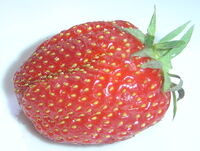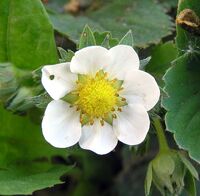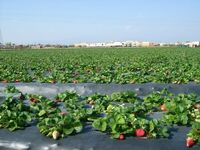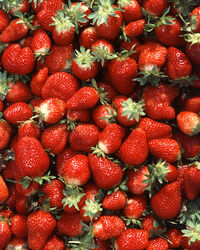
Fragaria × ananassa 'Gariguette'
Strawberries are fruits made by several species of Fragaria plants, but the most widely known strawberries are the garden strawberry, Fragaria × ananassa, and the woodland strawberry, Fragaria vesca.
Cultivation[]

F ananassa flower
Cultivars of strawberries vary in size, color, shape, fertility, season of ripening, disease resistance, and constitution of plant. Some vary due to foliage, but some also vary by the relative development of their sexual organs. Most of the time, strawberry flowers are hermaphroditic, but function as either a male or a female.

Stawberries being grown through plasticulture
For purpose of commercial production, strawberries are propagated from runners, and distributed as either bare root plants or plugs. More modernly, strawberries have been cultivated using the process of plasticulture. In plasticulture, raised beds are made each year, fumigated, and covered with plastic to prevent weed and fungal growth. Strawberries from northern nursery are planted through holes punched in the plastic, while irrigation tubing flows underneath the plastic. The runners are removed so that the strawberries can grow more fruit than reproduce. At the end of the harvest, the plastic is removed, and the remaining strawberry plants are plowed into the ground.
Another method of cultivating strawberries is growing them on rows on mounds. This method is common in cold climates.
A third method uses compost socks. Strawberries grown in compost socks produce more oxygen radical absorbance capacity (OPAC), flavonoids, anthocyanins, fructose, glucose, sucrose, malic acid, and citric acid than the other used systems.

Chandler strawberries
Strawberries are usually grouped due to flowering habit. Traditionally, this consists of "june-bearing" strawberries, which have fruit in the early summer, and "ever-bearing" strawberries, which grow fruit throughout the whole growing season.
Strawberries may also be propagated by seed, but this is usually a hobby activity, and usually not practiced commercially. A few seed-propagated cultivars have been made for use at homes. The seeds (achenes) are usually acquired by commercial suppliers, or by collecting them from the fruit.
Strawberries can be grown indoors in strawberry pots.
Manure and harvesting[]
Most strawberries are now fed with artificial fertilizers, before and after harvesting, and often before planting during plasticulture.
The harvesting and cleaning of strawberries hasn't changed much over time. The delicate fruits are usually harvested by hand. Grading and packing usually occurs in a field, and not in a manufacturing facility. In several large operations, strawberries are washed by water streams and shaking conveyor belts.
Pests[]
There are around 200 species of pests that will attack strawberries, directly and indirectly. Some examples include slugs, moths, fruit flies, chafers, strawberry root weevils, strawberry thrips, strawberry sap beetles, strawberry crown moths, mites, aphids, and several members of Lepidoptera.
Diseases[]
For a list, see List of strawberry diseases
Strawberry plants can get several diseases. Leaves may be attacked by powdery mildew, leaf spot, leaf blight, and by several slime molds. The crown and roots may be attacked by red stele, verticillium wilt, black root rot, and nematodes. The fruits can suffer to gray mold, rhizopus rot, and leather rot. The plants can also develop diseases during winter.
Production[]

Strawberry production
| Country | 2005 | 2006 | 2007 | 2008 |
|---|---|---|---|---|
| 100,000 | 100,000 | 104,000 | 200,254 | |
| 146,500 | 173,230 | 158,658 | 150,854 | |
| 146,769 | 131,305 | 57,670 | 155,583 | |
| 196,200 | 190,700 | 193,000 | ||
| 162,627 | 191,843 | 176,396 | 207,485 | |
| 118,600 | 112,000 | 100,000 | 130,000 | |
| 184,627 | 193,666 | 174,578 | 200,723 | |
| 221,000 | 227,000 | 230,400 | 145,000 | |
| 201,995 | 205,307 | 203,227 | ||
| 320,853 | 333,485 | 263,900 | ||
| 200,000 | 211,127 | 250,316 | 261,078 | |
| 68,600 | 73,900 | 87,200 | ||
| 1,053,242 | 1,090,436 | 1,133,703 | 1,148,530 | |
| Total world | 3,782,906 | 3,917,140 | 3,824,678 | 4,068,454 |
Agronomy[]
Strawberries are very easy to plant, and can be grown almost anywhere on Earth. The best thing to do is to buy a plant in early spring. Place the plant in full sun, and slightly sandy soil. When the plant is bearing fruit, give it more water than usual. Strawberries can also be potted, and will produce fruit.
The plant will eventually send out shoots in attempt to propagate a new plant. You can cut off this shoot, and plant it anywhere you please.
Uses[]

Strawberries
Strawberries are edible, and can be eaten fresh, or frozen and dried. Strawberries are popular in flavoring things, such as milk, smoothies, ice cream, milkshakes, yogurt, and candy. Strawberry pie and Strawberries and Cream are also widely eaten.
Nutrition[]
One cup of strawberries contains about 45 calories, and is a good source of vitamin C and flavonoids.
| Category | Nutrient | Units | 1 cup (144 g) whole |
|---|---|---|---|
| Proximates | Water | g | 132 |
| Energy | kcal | 43 | |
| Energy | kJ | 181 | |
| Protein | g | 0.88 | |
| Total lipid (fat) | 0.53 | ||
| Carbohydrate, by difference | 10.1 | ||
| Fiber, total dietary | 3.3 | ||
| Ash | 0.62 | ||
| Minerals | Calcium | mg | 20 |
| Iron | 0.55 | ||
| Magnesium | 14 | ||
| Phosphorus | 27 | ||
| Potassium | 240 | ||
| Sodium | 1.44 | ||
| Zinc | 0.19 | ||
| Copper | 0.07 | ||
| Manganese | 0.42 | ||
| Selenium | µg | 1.01 | |
| Vitamins | Vitamin C, ascorbic acid | mg | 82 |
| Thiamin | 0.03 | ||
| Riboflavin | 0.1 | ||
| Niacin | 0.33 | ||
| Pantothenic acid | 0.49 | ||
| Vitamin B-6 | 0.09 | ||
| Folate | µg | 25 | |
| Vitamin B-12 | µg | 0 | |
| Vitamin A, IU | IU | 39 | |
| Vitamin A, RE | µg RE | 4.3 | |
| Vitamin E | mg ATE | 0.20 | |
| Lipids | Fatty acids, saturated | g | 0.03 |
| 16:0 | 0.02 | ||
| 18:0 | 0.006 | ||
| Fatty acids, monounsaturated | 0.075 | ||
| 16:1 | 0.001 | ||
| 18:1 | 0.073 | ||
| Fatty acids, polyunsaturated | 0.27 | ||
| 18:2 | 0.16 | ||
| 18:3 | 0.11 | ||
| Cholesterol | mg | 0 | |
| Phytosterols | 17 | ||
| Amino acids | Tryptophan | g | 0.01 |
| Threonine | 0.027 | ||
| Isoleucine | 0.02 | ||
| Leucine | 0.045 | ||
| Lysine | 0.036 | ||
| Methionine | 0.001 | ||
| Cystine | 0.007 | ||
| Phenylalanine | 0.026 | ||
| Tyrosine | 0.030 | ||
| Valine | 0.026 | ||
| Arginine | 0.037 | ||
| Histidine | 0.017 | ||
| Alanine | 0.045 | ||
| Aspartic acid | 0.20 | ||
| Glutamic acid | 0.13 | ||
| Glycine | 0.035 | ||
| Proline | 0.027 | ||
| Serine | 0.033 |
Allergy[]

Wild F. vesca
Some people experience an anophylactoid reaction when eating strawberries. The most common form of this is oral allergy syndrome, and less commonly something like hay fever, dermatitis or hives, and in severe conditions, problems with breathing. Research suggests that these reactions could be caused by a protein involved in ripening the fruit, Fra a1 (Fragaria allergen1).
White-fruited strawberry cultivars lack Fragaria allergen1, which may be a substitute for normal strawberries by allergy sufferers. Since they lack the protein needed for ripening, the don't produce flavonoids, which make normal strawberries red. They will ripen, but only become shades of white, yellow, or "golden". They appear like immature strawberries, which is why birds often stay away from them. A nearly allergen-free cultivar named 'Sofar' is available.